The 1964 Lincoln penny may seem like just another common coin, but certain examples can be surprisingly valuable. What makes one worth just a cent and another worth hundreds—or even thousands—of dollars?
Let’s dive into the value of the 1964 penny and discover the key factors that influence how much it’s worth. Along the way, we’ll explore its background, mint marks, and the different types of coins produced that year.
Ready to learn what makes your 1964 penny potentially special? Let’s begin!
1964 Lincoln Penny Value Overview
| Mint Mark | MS63 | MS65 | MS67 |
|---|---|---|---|
| 1964 (No Mint Mark – Philadelphia) | $6 | $18 | $1,000 |
| 1964 D (Denver) | $6 | $16 | $650 |
| Type | SP63 | SP65 | SP67 |
|---|---|---|---|
| 1964 Special Mint Set (No Mint Mark) | $2,650 | $11,500 | $18,500 |
| Proof Grade | PR63 | PR65 | PR67 |
|---|---|---|---|
| 1964 Proof (No Mint Mark) | $7 Cameo: $10 Deep Cameo: $12 | $10 Cameo: $14 Deep Cameo: $20 | $18 Cameo: $20 Deep Cameo: $32 |
Note: All values listed refer to coins with a red (RD) designation, which are generally the most desirable among collectors.
History of the 1964 Penny

The 1964 penny belongs to the long-running Lincoln cent series, which first debuted in 1909. These coins were introduced to honor the 100th anniversary of Abraham Lincoln’s birth and marked a historic milestone—they were the first U.S. coins to feature a real person.
The original design featured Lincoln’s profile on the obverse, while the reverse showed a pair of wheat ears—earning it the nickname “Wheat Penny.” This design remained in use until 1959, when the Mint introduced a new reverse to celebrate Lincoln’s 150th birthday.
The updated design came from Frank Gasparro, who was serving as the Assistant Engraver at the time. His creation depicted the Lincoln Memorial in Washington, D.C., complete with a tiny image of Lincoln’s statue visible between the columns—making it one of the few U.S. coins to feature the same person on both sides.
This Lincoln Memorial design continued through 2008, after which it was replaced by the Union Shield reverse, the design still in use on modern Lincoln cents today.
Features of the 1964 Penny
The Obverse of the 1964 Penny
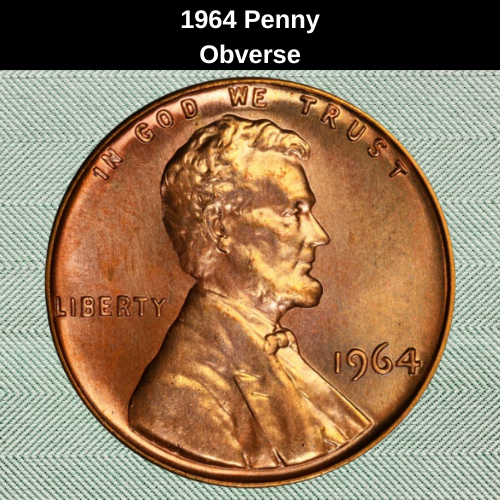
Take a look at the obverse, or “heads” side, of a 1964 penny, and you’ll instantly recognize the image—it’s the same portrait of Abraham Lincoln that’s been featured on the cent for more than a century.
This iconic likeness was created by Victor David Brenner, who depicted Lincoln in right-facing profile. Brenner once explained that he envisioned Lincoln in a warm, human moment—reading to a child—as he aimed to capture a gentle, approachable expression. It’s widely believed that the design was inspired by a photograph taken at Matthew Brady’s studio, though it’s unclear whether Brady himself or one of his assistants snapped the original image.
Like most coin artists of the time, Brenner included his initials on the coin. His first idea was to place them on the front, but Mint officials rejected that. He settled on including them on the reverse—but their prominent placement caused a stir. Critics argued that it looked like self-promotion, leading the Mint to remove them entirely. It wasn’t until 1918 that the initials “VDB” returned—this time in a subtle spot on the cut-off at the base of Lincoln’s bust, where you can still find them on the 1964 penny.
Above Lincoln’s head, the national motto “In God We Trust” is clearly inscribed. To the left is the word “Liberty”, and the date appears on the right. If your coin has a small “D” beneath the date, it means it was minted in Denver.
The Reverse of the 1964 Penny
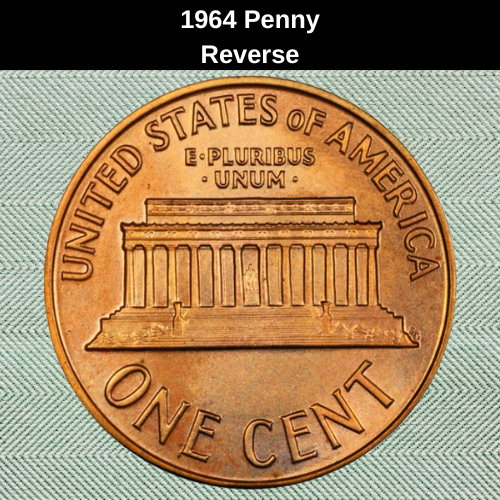
The reverse of the 1964 penny features the Lincoln Memorial, a famous landmark located in Washington, D.C. If you examine the design closely, you’ll notice a tiny depiction of Lincoln’s statue seated inside the memorial’s central chamber. This makes the coin especially unique—Lincoln appears on both the front and back, a rare feature in U.S. coinage.
At the bottom of the reverse, the denomination is spelled out in bold capital letters as “ONE CENT,” arching along the lower rim of the coin. The country’s name, “UNITED STATES OF AMERICA,” is displayed at the top, also following the curve of the edge.
Just below the country name, running in a straight line, is the Latin phrase “E PLURIBUS UNUM.” This motto translates to “Out of many, one,” symbolizing the unification of the original states into a single nation.
Additional Details About the 1964 Penny
The 1964 Lincoln penny shares the same size and metal composition as most earlier Wheat pennies. It has a diameter of 19 millimeters and weighs 3.11 grams. The metal mix includes 95% copper and 5% zinc.
Because of its high copper content, the coin’s appearance can vary significantly. Freshly minted copper coins have a bright reddish tone, but exposure to air and handling causes the color to oxidize and darken, eventually becoming brown.
Professional coin graders consider this color change when evaluating a coin’s condition. If a penny remains at least 95% red across both sides, it is classified as “Red” (RD). Coins that are 95% brown are graded as “Brown” (BN), while those that fall somewhere in between are labeled “Red and Brown” (RB).
Generally speaking, Red coins are the most desirable and valuable to collectors, followed by Red and Brown, with Brown coins typically being the least valuable of the three.
1964 Penny Grading Scale
Coins are graded on a numerical scale from 1 to 70, with higher numbers indicating better condition. Here’s how the grades break down:
| Grade | Description |
|---|---|
| 1 | Basal State |
| 2 | Poor |
| 3 | Very Poor |
| 4–6 | Good |
| 7–10 | Very Good |
| 12, 15 | Fine |
| 20, 30 | Very Fine |
| 40 | Extremely Fine |
| 50 | About Uncirculated |
| 60 | Mint State (uncirculated) |
| 65 | Mint State (higher grade) |
| 70 | Perfect Mint State |
Understanding where your penny falls on this scale is essential for determining its true value. Be sure to consult a detailed grading guide or have your coin evaluated by a professional if you’re unsure.
1964 Penny Value Guides
1964 (P) No Mint Mark Penny Value
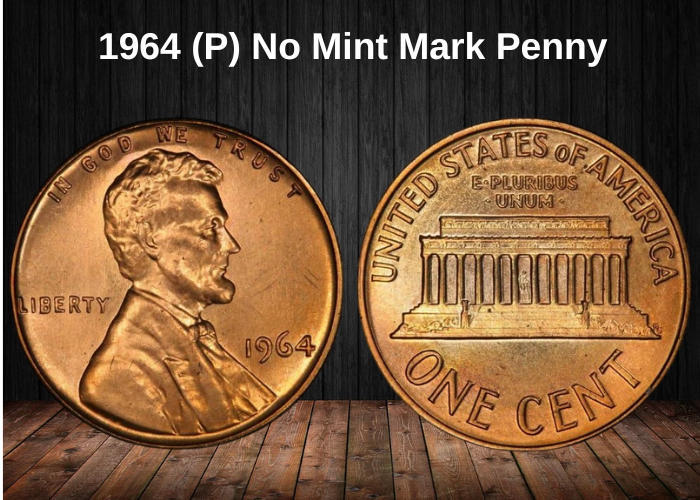
If your 1964 penny doesn’t show a mint mark beneath the date on the obverse (front) side, it was minted in Philadelphia. That facility didn’t use mint marks at the time.
Nearly 2.5 billion of these pennies were produced in Philly, with close to 1 billion likely struck in 1965 using leftover 1964 dies.
Because of this massive production, 1964 Philadelphia cents are still common today, and most are only worth their face value.
To fetch higher prices, a penny needs to be in excellent shape—especially if it’s a red variety. Red and brown versions must meet even stricter quality standards to gain value, and brown coins, even in top condition, typically sell for less than $1 unless they feature a notable error.
Coins are graded on a scale from 1 to 70, with 1 being the lowest condition (barely identifiable) and 70 indicating a flawless example.
A red MS63 1964 penny is valued at about $6, while a red-brown MS63 coin is worth just $2.
The highest-graded red-brown example is MS66+, with only one coin certified at that level by PCGS, and it’s worth around $40.
Red coins in better conditions can command significantly higher prices. At MS66+, a red penny is worth approximately $65, but if it reaches MS67, the value jumps dramatically to $1,000.
The most valuable red 1964 Philadelphia pennies are graded MS67+. Only three coins have achieved this grade, and each is valued at an impressive $13,500.
1964 D Penny Value
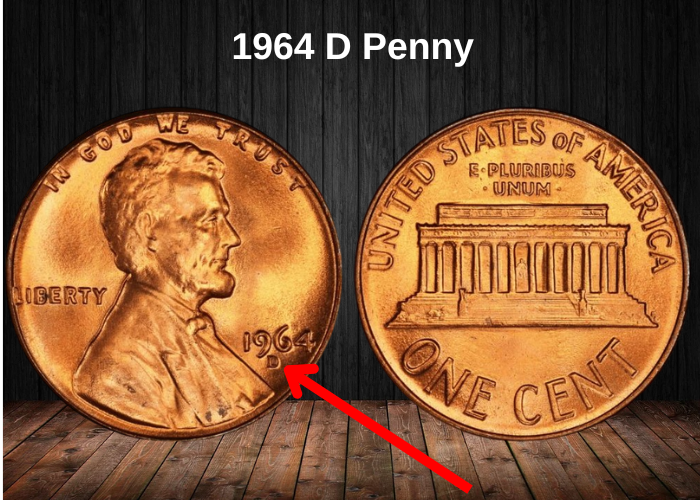
In 1964, the Denver Mint produced even more Lincoln pennies than the Philadelphia Mint—nearly 3.8 billion in total.
In terms of value, most grades of Denver-minted coins are comparable to their Philadelphia counterparts. Just like those, unless the coin is a red variety or has a notable error, it’s unlikely to be worth more than face value.
A red 1964-D penny graded MS63 typically fetches around $6, identical to a Philadelphia issue. In MS65, it sees a slight bump to $16.
But values rise significantly at higher grades. A Denver penny graded MS67 is worth about $650, according to PCGS.
The highest-graded 1964-D pennies are MS67+, with seven known specimens at that level. Each of these is estimated to be worth approximately $4,750.
1964 (P) No Mint Mark Special Mint Set Penny Value
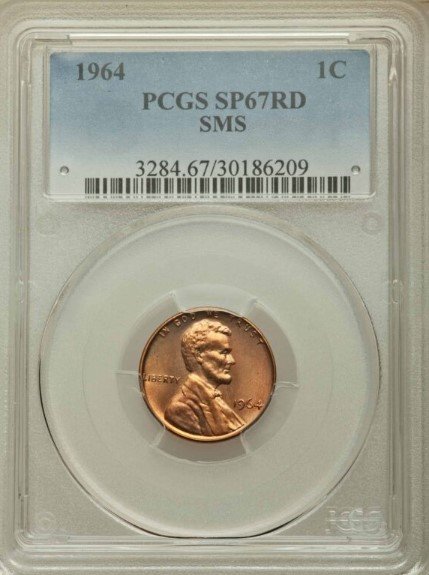
In 1964, the Philadelphia Mint is believed to have produced a small number of Special Mint Set (SMS) pennies, though the reason remains unclear.
Typically, SMS coins are issued in years when proof sets aren’t made, and are intended for collectors. But since proof pennies were produced in 1964, the purpose behind these special strikes is still somewhat of a mystery.
There’s no official record of how many were made, but estimates suggest only a few dozen exist. That extreme rarity makes them highly valuable if you come across one.
These coins can be identified by their distinct finish—a satin-like surface that’s less shiny than proofs but clearly different from standard business strikes. They also feature sharp strikes and squared-off rims, which further set them apart.
Since they were never intended for circulation, grading for these coins begins at SP60. According to the PCGS, an example at this level is valued around $1,300, rising to $11,500 at SP65, and reaching up to $21,500 for those graded SP67+.
1964 (P) No Mint Mark Proof Penny Value
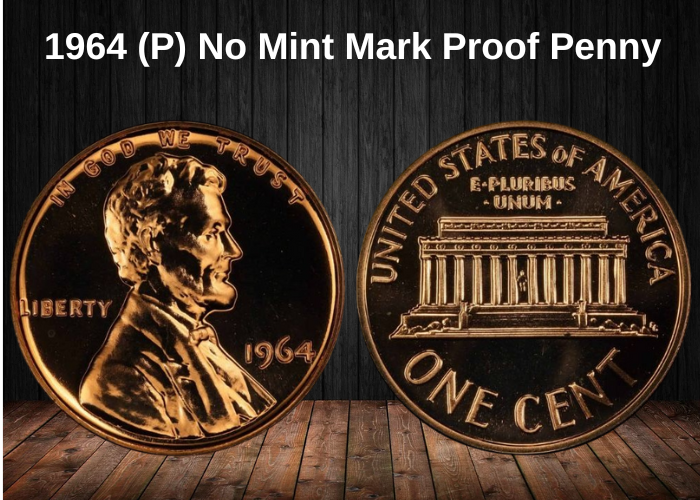
In 1964, the Philadelphia Mint produced nearly 4 million proof pennies, making them easier to find than the special strike pennies.
These proof coins were created with specially prepared dies and highly polished planchets, resulting in a glossy finish with sharp, clear details. Since they were aimed at collectors, all of these coins are in uncirculated condition.
A 1964 proof penny graded PR60 has a value of approximately $6, with prices increasing steadily as the grade goes up. A coin graded PR68 is valued at about $75 by the PCGS.
Higher-quality examples are much rarer. A PR69 grade penny can fetch around $340, and the highest grade, PF70, has been valued at an impressive $12,500 by the PCGS.
Rare 1964 Penny Error List
1964 (P) No Mint Mark Penny Struck on Clad Dime Planchet
Occasionally, coins are struck on the wrong planchet, and this happened with a 1964 penny minted in Philadelphia. Instead of being struck on a penny planchet, it was mistakenly struck on a planchet intended for a dime.
As a result, the coin is too small for the typical penny design, causing the design to disappear over the edges. Despite this flaw, the coin wasn’t caught during the Mint’s quality assurance processes and eventually made its way into circulation.
Interestingly, this particular error coin was in excellent condition, graded MS64 by the ANACS. In 2004, the coin was auctioned and sold for an impressive $5,750.
1964 D Penny Struck on 1951 D Penny
Another fascinating error coin from 1964 is the 1964 D penny struck on a 1951 D penny planchet. This type of error happens when a coin is struck on an already used planchet, which still bears the imprint of the original design from a previous minting year.
In this case, the 1964 D penny was struck on top of a 1951 D penny, and you could still see parts of the earlier design, including the date and the word “Liberty” on the obverse.
This coin was graded AU58 (about uncirculated) by the NGC, and because of its rarity and unique nature, it sold at auction for a remarkable $1,800.
Error coins like these are highly sought after by collectors, as they provide a glimpse into the mistakes that can occur during the minting process, making them valuable and fascinating pieces of numismatic history.
1964 D Over D Penny, Re-punched Mint Mark
The 1964 D Over D penny is another intriguing error coin. As with other Denver-struck coins, the “D” mint mark is stamped on the obverse to identify the mint location. However, in some cases, a second “D” is visible next to the first, resulting in what’s known as a re-punched mint mark (RPM).
While this error type is more common compared to others, it still adds an interesting detail for collectors. Despite the occurrence of this error being somewhat frequent, 1964 D Over D pennies are still collectible. For example, a 1964 D penny with this RPM, graded MS65 red by ANACS, sold at auction for around $10.
While the value of these error coins may not be sky-high, they’re still sought after by collectors who appreciate minting anomalies, making them a valuable addition to many collections.
Where to sell your penny?
Now that you know the value of your penny, you might be wondering where to sell it. Don’t worry: here’s a guide to some of the best online platforms where you can easily sell your coins, along with their advantages and disadvantages.
Discover the best platforms for selling coins online (pros and cons).
FAQ About the 1964 Lincoln Penny
1. What is the historical significance of the 1964 Lincoln Penny?
The 1964 Lincoln Penny is part of the Lincoln Memorial series, which ran from 1959 to 2008. It marks the final year before the U.S. Mint changed the design of the reverse side of the penny to the Shield Reverse in 2010. This coin represents a time of significant social and economic change in the United States, including the aftermath of the Kennedy assassination in 1963 and the civil rights movements. The 1964 penny itself doesn’t have unique design elements but reflects the final years of the Lincoln Memorial design that had been in use since 1959.
2. What is the composition of the 1964 Lincoln Penny?
The 1964 Lincoln Penny is made from:
- 95% copper
- 5% tin and zinc
It weighs 3.11 grams, which is the standard weight for pennies minted between 1909 and 1982, before the shift to copper-plated zinc pennies in 1982.
3. How many 1964 Lincoln Pennies were minted?
In 1964, the U.S. Mint produced an extraordinarily large number of Lincoln pennies due to high demand. The total mintage of the 1964 Lincoln Penny is as follows:
- Philadelphia Mint (no mintmark): 1,181,877,000
- Denver Mint (D mintmark): 2,443,440,000
This brings the total mintage for the year to a massive 3.6 billion coins, making the 1964 penny one of the most commonly found coins in circulation, especially in circulated condition.
4. What is the value of a 1964 Lincoln Penny today?
The value of a 1964 Lincoln Penny primarily depends on its condition and whether it has any special features. Here’s a rough estimate:
| Condition | 1964 (No Mintmark) | 1964-D |
|---|---|---|
| Circulated | $0.01–$0.05 | $0.01–$0.05 |
| Uncirculated (MS60) | ~$0.10–$0.25 | ~$0.10–$0.25 |
| MS63 Red | ~$1–$2 | ~$1–$2 |
| MS65 Red | ~$3–$5 | ~$3–$5 |
| With major errors | Varies ($10–$100+) | Varies ($10–$100+) |
Coins in high-grade uncirculated (MS-65 or higher) condition can bring in around $3–$5, but their value will depend on the preservation and quality of the coin.
5. Are there any rare error varieties or special features in the 1964 Lincoln Penny?
While the 1964 Lincoln Penny does not have any major or widely recognized varieties, minor errors have been found:
- Die cracks: Raised cracks from damage to the die, often seen along the coin’s edge.
- Off-center strikes: When the planchet is misaligned in the press, resulting in an off-center design.
- Clipped planchets: Missing sections of the coin due to issues during the blanking process.
- BIE error: A die break between the “B” and “E” in “LIBERTY”, making it appear like an “I”.
These errors can add value to the coin, particularly if they are found on uncirculated examples.
6. How do I identify a high-grade 1964 Lincoln Penny?
To identify a high-grade 1964 penny:
- Sharp details: The portrait of Lincoln and the wheat stalks on the reverse should be well-defined, with no visible wear or fading.
- Clean surfaces: There should be minimal contact marks, abrasions, or scratches on the coin’s surface.
- Strong luster: Uncirculated coins will show shiny, reflective surfaces with little to no tarnish.
- Well-defined rims: A well-preserved penny will have sharp, intact rims that show no signs of wear.
Coins graded MS-65 or higher should show very few imperfections, retaining their original shine and detail.
7. Is the 1964 Lincoln Penny worth collecting?
Yes, even though the 1964 Lincoln Penny is common, it can still be worth collecting for several reasons:
- If you’re collecting high-grade examples of the Lincoln Memorial series.
- For those interested in error coins, the 1964 penny offers potential value with die cracks, off-center strikes, or BIE errors.
- The 1964 penny marks the end of an era, representing the last year before the design change to the Lincoln Memorial reverse.
While it may not be as rare as some earlier years, the 1964 penny remains a solid piece for collectors due to its significant mintage and historical context.


















































